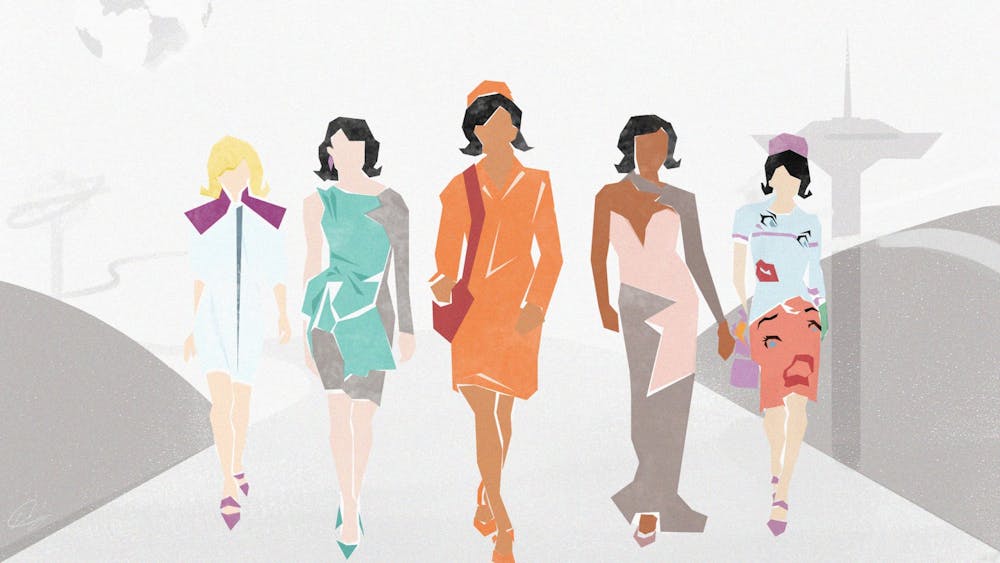Given Polyvinyl chloride, foil insulation, and metal plugs, the last thing to come to mind for most people would be a high–fashion runway show—but for the pioneers of The Space Age fashion movement, these construction materials were nothing short of inspiring.
Emerging in the mid–1960s, The Space Age movement in couture was known not only for its eccentric materials, but for its cartoonish silhouettes, helmet–shaped hats, insulated dresses, and of course, moon boots. America was entering a new era that provided a stark contrast to the traditional feminine figures and delicate patterns in women’s fashion of the 50s. And as with any fashion trend, this shift didn't appear out of nowhere; it was a reaction to the politics and cultural mentalities of the respective decades.
Coming out of World War II, the United States sought a return to normalcy with the breadwinner husband and the obedient housewife—think the scenes in Don't Worry Darling and Edward Scissorhands where the husbands simultaneously pull out of their driveways in matching cars as their wives wave them off. And of course, the stunning Florence Pugh and Dianne Wiest can be spotted in princess–style silhouettes that create the desired womanly hourglass shape.
Despite longing for the past, this era of conservatism offered a new promise: the accessibility of space. Even if you knew nothing about the Space Race or Russia, it was impossible to escape space culture in mid–century America. Whether you were eating Kellogg’s Solar Cereal, fighting bad guys with the Mighty Robot toy, or swinging along to Bart Howard’s “Fly Me to the Moon,” the whole nation was captivated by the idea of achieving the impossible. However, as exciting as this new possibility was, space was and still is only accessible to the select few. At its core, the Space Race remained another example of American expansionism in the hope to preserve our traditional values against communism.
In contrast, Space Age fashion was a visual means of declaring that we were ready for a new age, an age that had women as an active, powerful part of society. French designer André Courrèges is known to be one of the first and most influential contributors to the trend. His 1964 “Space Age” Spring Collection utilized PVC pipes and plastic to create calf–high alabaster moon boots, scandalously short and straight dresses, and extraterrestrial–inspired glasses. Yet somehow, the most shocking aspect of the show was not the clothes themselves. In a field where the fatigued, malnourished look often prevailed, Courrèges had his athletic models dancing along to jazz music in a vibrant promotion of female health.
In that same year, Italian–French engineer and designer Pierre Cardin emerged with his “Cosmos'' collection: an androgynous line that ignored the female figure to create pieces in unexpected shapes. Light bulb–shaped wool dresses, feathered hats, and circular ruby red raincoats are some of his signature looks.
Despite the shape, his clothing remains flexible and moveable for the modern woman. In a 2010 interview with the New York Times, Cardin states, “My way was to draw something of the future—to be young, to see that a woman could be free. I wanted to give women in the 1960s a chance to work, to sit, to take the car and drive in my dresses.”
For the woman working on Braniff Airlines, designer Emilio Pucci’s 1965 functional yet stylish flight attendant collection was unlike any work attire seen before. Complete with astronaut–inspired helmets to protect their face and hair on the tarmac with comfortable shift dresses and matching heavy cotton coats, these women could embrace the future in the most fashionable uniforms.
Within the decade, futuristic styles made their way from catwalks to television and film. Paco Rabanne’s costumes for Jane Fonda’s portrayal of the titular character in Barbarella flaunted chainmail crop tops and metal corsets that would become staples for the style. Even series such as Star Trek and The Jetsons sparked interest in the new wave of fashion. However, despite being based on the future, Space Age fashion became a thing of the past as the more down–to–earth, flowy fashion of the 70s emerged. It wouldn’t be until the late 2010s that Space Age fashion would make a return.
In 2017, the Chanel Fall/Winter 2017/18 Show came with an out–of–this world surprise as a 35–meter faux rocket “launched” during the show, and with it, the re–emergence of Space Age fashion. The models—adorned with planet prints, metallic pants even space blankets—strutted around the launch pad.
The following year, Moschino would release their Ready–to–Wear collection, notably inspired by the 60's style icon known for her tweed skirt–suits and bouffant haircut. Each model was painted head–to–toe in blue, green, or purple: the collection’s otherworldly twist on Jackie Kennedy’s iconic style.
The year 2017 was a monumental chapter in American history, and not just for outlandish fashion. It was the year of a turbulent inauguration that would split parties for years to come, wildfires roared at a rate never seen before, and rising ocean temperatures caused the trillion–ton Larsen Ice shelf to break off. America yearned for a future wildly different from what we were experiencing, and just as it came half a century ago, Space Age fashion emerged from the shadows as a plea for a better, more progressive tomorrow. With a fire that has only grown across our natural world, it's no wonder that we are looking to the stars for hope.

